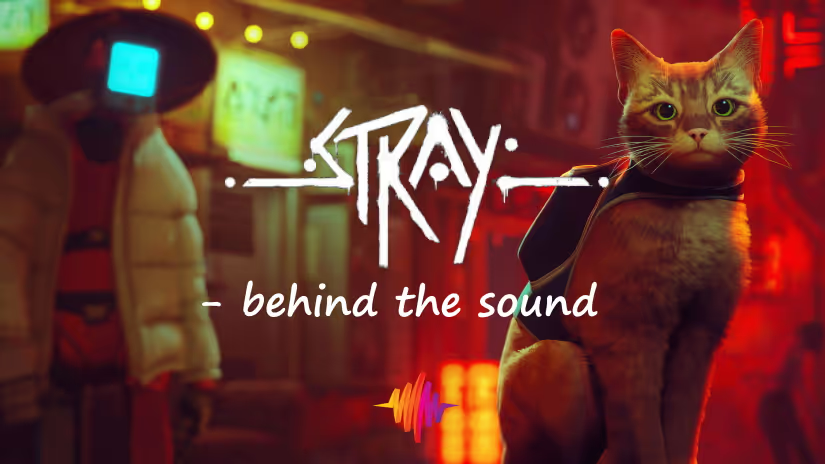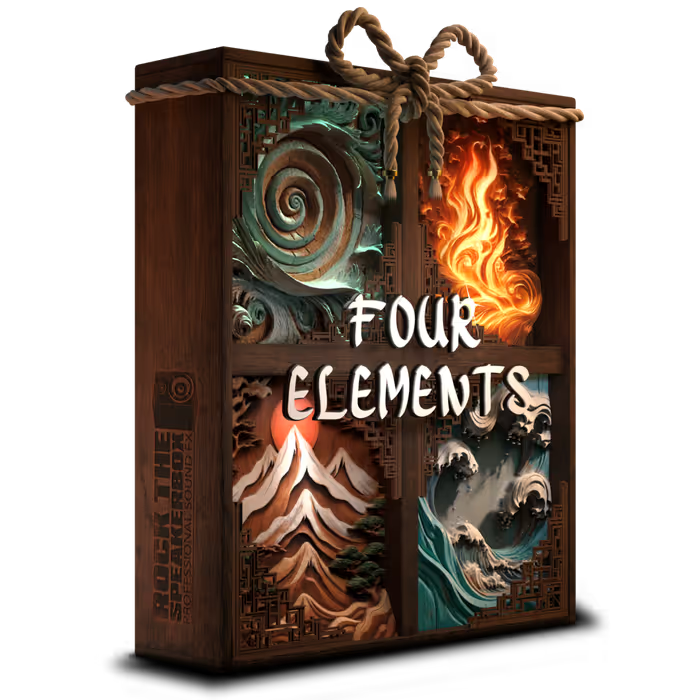BlueTwelve Studio couldn’t have picked a more perfect protagonist for its platformer-puzzle adventure game Stray, as cats are naturally agile and curious. As a cat in a robot-run post-apocalyptic world, the player must leap from trash cans to airconditioners to rooftops, walk along narrow edges, poke around confined spaces and search for items to assist the robots (and the cat) in finding a way to free Dead City from the Zurks and Sentinels and open it back up to the outside world.
Dead City is devoid of humans, but the resident robots have taken up the responsibility of keeping it going. They’ve sectioned off zones safe from the infestation of predatorial mutated bacteria called Zurks – which are reminiscent of pustular bug-rats. The city’s perpetual darkness is pierced by the neon glow of shop signs and street lights. For being so desolate, it’s quite lovely in the safe zones.
Here, sound designers Yann van der Cruyssen (also composer) and Raphaël Monnin (at BlueTwelve Studio) talk about building the sound of this city, recording cat vocals and foley sounds for its movement, crafting vocals and mechanical sound design for the different robots, bringing the Zurks and Sentinels to life, overcoming creative and technical challenges like getting real-time events to seamlessly blend with cinematics, and so much more!
Stray – Official Launch Trailer
What was your inspiration for the sound of the Dead City in Stray?
Yann van der Cruyssen (YC): I recorded many ambient soundscapes, some of them were recorded in Japan, some in Korea, and some in France during the 2020 Covid lockdown (so they’re urban but unusually silent). I went through all of them and manually removed all the human components. Then I classified them and sometimes altered them.

I then faced an interesting challenge: I wanted soundscapes made of very distant hardly identifiable elements. I didn’t want to use stereo loops for that purpose since I knew there would be a lot of twisty passages where the player would turn a lot and the stereo field would just “follow” the rotation of the camera.
I also didn’t want to place distant sounds in physical locations that could be seen and approached when nothing graphical was associated with them. So I created dedicated objects to be placed in levels; these objects scan the surrounding level at start and then either spawn or continuously play several independent localized sound sources. They treat panner and gain separately in a way that is somehow not physically correct to ensure none of the two unwanted behaviors described earlier happen. You can hear an example of that quite clearly in the beginning of Dead City where it is used to play moving bursts of debris around the first street.

What was your approach to the cat sounds in the game? Did you capture custom cat recordings? Use libraries? Did you perform any of the cat sounds yourselves?
YC: At first I tried to record cats or ask some friends who live with cats to record them. It was tricky. Later, we used cats from soundbanks in addition to those recordings.
All the meows were modified (in terms of pitch, length, EQ, etc.) to make them more consistent with each other. They were sorted into several categories (probably about fifteen) such as: grumpy, engaging, discreet, etc. The game uses one or another depending on the situation.
The few meows that you end up hearing the most in the game probably turn out to be those recorded by french developer Eric Chahi; they’re of a cat that apparently shows up and meows in his garden every day at the same time, quite convenient for recordings.
I didn’t “perform” any sound myself but I suspect Raphaël did for some idle moves.

It has also been discussed whether the cat should feel “first person” (i.e., loud, close, stereo, not reverberated, etc.) or just as one tiny element among others; we preferred the second option most of the time.
Raphaël Monnin (RM): We created the cat sounds to be as realistic and immersive as possible – close to a real cat yet we tried to give it emotion. As we spend the entire game with it, we wanted the player to really feel connected with the cat, and we believe that the foley helps to achieve that.
In terms of performance, yes, some sounds were done for idle moves and also during some cinematics.

Did you do a lot of foley for Stray? For instance, were the cat movements done in foley? What about the objects that the cat interacts with – was that foley or hard effects?
YC: We tried to avoid sound banks as much as possible so, with the exception of a few challenging sounds like cat meows, I was able to record numerous foley sounds from my home using random everyday objects.
For the fantasy elements, I usually heavily processed everything and used synthesis a lot.
To render the ground props as accurately as possible, we…create an Unreal component dedicated to physics audio.
To render the ground props as accurately as possible, we teamed up with Antonin, one of the programmers, to create an Unreal component dedicated to physics audio. The component knows if an object is rolling, sliding, or simply hit, and uses both loops and one-shots, often with multiple round-robin or velocity-mapped alternatives.
RM: Yes, for the cat movements we wanted to get unique sounds so we recorded nearly all the foley: footsteps, jumps, and lands on different surfaces (we have 28 in total) such as concrete, dirt, carpet, water, wood, tile, plastic, metal, etc. and we also recorded scratches on different surfaces (wall, tree, carpet, metal, etc.).
…we recorded nearly all the foley: footsteps, jumps, and lands on different surfaces…
We tried them in the game and if we weren’t happy with the results, we restarted the process again until we were satisfied.
As for all the objects the cat interacts with (mostly props), as Yann said above, it comes from our recordings of many variations from everyday objects from our home, to get the most organic and realistic sounds without being redundant.
We also recorded some foley for most of the droids’ actions and cinematics.
[tweet_box]Behind the Purr-fect Sound of ‘Stray'[/tweet_box]

What was your approach to the robot sounds? How did you create those, and were there plugins or processing that was helpful?
YC: For movements (articulations, footsteps, etc,) we used a mix of physical foley and synthesis.
For the voice, this was a very long process and we tried many different approaches over the years. I initially started with very abstract “modem-like” sounds (I created a few pure data patches for that purpose) and a system that concatenated many chunks of sounds associated with each letter or punctuation in real-time.
…the voices should sound more “speech-like” but I was still aiming for something more artificial…
At some point along the way, the text that appeared on-screen changed and this approach didn’t make sense anymore. Also, it had been requested that the voices should sound more “speech-like” but I was still aiming for something more artificial than, say, continuous human speech ran through some kind of vocoder.
I ultimately used recorded voices (including mine and my parents’) that I cut into many small chunks, and put into a long synthesis and processing chain that included many effects.
The voice of B12 and some of the voice-like sounds that come from radios or screens are different and have been made with other generative methods.

What went into the sound of the Zurks?
YC: This was a mix of physical modeling, suction cup manipulations, and various additional layers.
Since there is often an unpredictable number of Zurks around the player, there are a lot of upfront evaluations done on the Unreal side to decide where, when, and what sound to spawn in order to give an accurate idea of the Zurks locations without overloading the concurrency slots.

What about the sound of B-12?
YC: That involved a lot of synthesis, and random foley including a camera mechanism.
I’m not sure what exactly went into B12, sentinels, or other machines but some of the electrical-sounding hums and glitches have been recorded with unusual devices such as a ghost detector, a dying ’70s synthesizer, a chorus of badly grounded buzzing microcontrollers, and more.

What about the sound of Guardian, and Momo? How did you develop the voices/language for the different robot characters like Joris, Vinz, Morusque, Vapora, Kosma and so on…?
YC: I can create recognizable voices by tweaking parameters (such as pitch envelopes) in the robot voice generation chain I mentioned earlier.
In general in Stray, there is a lot of deterministic random to ensure a given game element will always sound the same.
In general in Stray, there is a lot of deterministic random to ensure a given game element will always sound the same. For instance, a given water drip, air conditioner, or electric hum somewhere will always use the same asset, pitch, and volume, so they are reliable for giving a sense of places and finding one’s way. Those values are randomized by default but we could always override them.
This principle also applies to some of the sounds used by robots, most importantly their voice. Most robots use one of the generic voices but we overrode them with unique samples for notable characters
RM: Also, some of the robots’ sounds, such as “droid’s reaction,” come from some unused voices that Yann previously made but weren’t used anymore in-game, so we decided that we could recycle some of them.
…some other droid reactions were created from trial and error while tweaking synthesizers…
We were cutting many variations from different sections that we found useful – for example, “the droid love reaction” when we see the heart on the robot screen. Also, some other droid reactions were created from trial and error while tweaking synthesizers and cutting parts that we found interesting to use. We then processed it using EQ, compression, distortion, etc when needed.
This was then implemented in-game with random pitch, random volume, etc. to get even more variations out of what we already had.

What were some of your creative challenges in terms of sound on Stray? How did you handle them, or what were your creative solutions?
It was sometimes challenging to readapt old content to an ever-changing world.
YC: When you play the final game, it’s not obvious how much every chapter has changed over time but most of them existed in many versions with very different puzzles, timings, or even general atmosphere. It was sometimes challenging to readapt old content to an ever-changing world.
I think I’m pretty happy about the way we handled this in the two “open” zones, for instance, when setting music triggers. Rather than a fixed linear planning, the music is a mix of several ‘playlists’ that use conditions, timers, and priorities to adapt to the player’s style as much as possible. Each tune is either strongly associated with a given action or randomly faded in after a certain period of silence or something in between.
the cinematic truck pursuit…was quite challenging because it starts in real-time and then switches to cinematic mode.
RM: The implementation of the cinematic truck pursuit (during the escape in Chapter 11: Jail) was quite challenging because it starts in real-time and then switches to cinematic mode. It was quite hard to manage the transition of these as the truck starts to accelerate when we are in real-time then after a while (when the player jumps in the truck), the game switches to the cinematic where we are still hearing the truck’s engine. It was quite tricky to get the truck engine connected from real-time to the cinematic, so we spent a lot of time on it to get it right.

What was the most challenging Chapter in terms of sound creation or implementation? Why?
YC: Probably the club. It was added very late in the project, at a point when I didn’t want to add any additional content to the game but just test it and debug. We had to add sound to the club mostly by reusing existing assets initially created for other levels – even the music wasn’t specifically composed for it.
We had to add sound to the club mostly by reusing existing assets…
Also, it was filled with audio challenges that had never occurred in the development so far, like strange geometry, streaming issues, testing issues, speaker busses, vinyl scratches, holographic robots (which is just a shader applied on a regular robot and doesn’t “know” it’s not supposed to make sounds), etc. We had to find dodgy solutions for many issues like these as quickly as possible.
RM: Another chapter that was quite challenging was the control room, particularly the roof opening sequence. This was quite complicated in terms of audio implementation. Because the sound of the roof opening starts during a cinematic and continues for some time afterward when we are back in real-time, it was quite difficult to get the roof sound consistent and connected all the way through. But in the end, I’m happy to say that we managed to make it work the way we wanted.

What were some of your technical challenges for sound on Stray? Can you share some specific examples and what the solutions entailed?
YC: One technique we used extensively for various reasons was playing one long audio loop with a variable starting offset: props sliding on the floor used the random offset for variety, in-game music kept track of the playhead position instead of restarting, voices used deterministic offsets associated with each sentence, distant ambient loops were often one big mono loop duplicated in various locations with shifted playheads, etc.
…we discovered that starting an audio file at an arbitrary point was not ‘simply’ possible on some platforms…
But about three months before the release of the game, we discovered that starting an audio file at an arbitrary point was not “simply” possible on some platforms for complicated reasons. I had to spend a month revising every system that used start offsets in a rush to replace them with other alternatives on a case-by-case basis.
We encountered some synchronization problems on different platforms such as PS4 and PS5 with audio artifacts such as crackles.
RM: One of the technical challenges that we encountered was doing the sound implementation of some cinematics – some were a mix of sounds triggered by notify events in animations, and some sounds were triggered in blueprints (visual scripting), or in the Unreal sequencer. We encountered some synchronization problems on different platforms such as PS4 and PS5 with audio artifacts such as crackles. We had to find some alternative solutions to solve those problems, but it would take some time to explain how we fixed them.
There was also a technical challenge regarding materials. Since, among other reasons, the surface colliding with the cat was often a simple box that was different from the actual visible surfaces, very often the sound didn’t match the visual (e.g., a concrete footstep when walking on a wooden surface) and we had to find some solutions between the programmers and us to fix all the issues in order for this to work properly.

Stray used the UE4 game engine. Was this a good fit for the sound team? Why? Also, did you use middleware like Wwise of FMOD?
YC: We didn’t use any middleware. It’s probably uncommon for that kind of project, but it would take too long to explain why we did it that way. We adapted our design choices to the Unreal audio engine workflow and built custom tools on top of it for some specific needs.
We adapted our design choices to the Unreal audio engine workflow and built custom tools on top of it for some specific needs.
On the upside, it was somehow practical to work with a single tool, having the audio logic and the gameplay logic in the same place. We could replace assets quickly without having to build soundbanks or extensively name everything. Also, their audio support team is very reactive and the engine itself has been improved a lot in just a few years.

In terms of your sound work on Stray, what are you most proud of?
YC: There are probably a lot of spots in the game that could have been treated with exaggeration (heavy focused sound design, illustrative cinematic music, etc.) but instead we mostly tried to go for a soft ambient approach with many small details. At some points, I wondered if I was on the right track about this but in the end, I’m glad we didn’t fall for the “spectacular” approach.
RM: It’s quite hard to choose what I am most proud of but if I have to say something about it, I’d say the foley that we’ve recorded, which included a lot of the cat sounds, the robot vocalizations, and the ambiance of every chapter which includes the music that Yann composed. I think all this together has helped to establish the tone of the game and to shape the story.
A big thanks to Yann van der Cruyssen and Raphaël Monnin for giving us a behind-the-scenes look at the sound of Stray and to Jennifer Walden for the interview!





